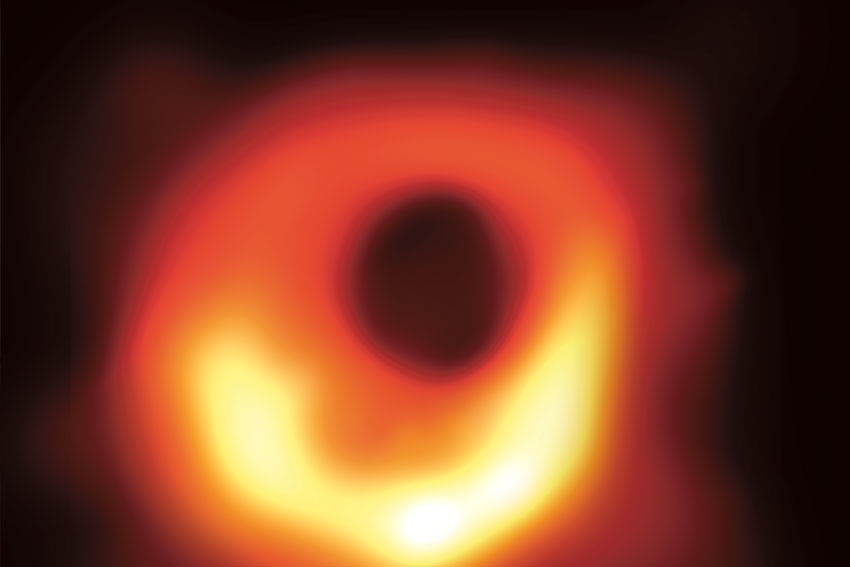Seeing the unseeable: that ‘black hole image’ explained

Last month, scientists captured an image of the universe’s most shadowy figure: a black hole.
Black holes have the status of space folklore: hope you never get close enough to see one in the flesh. Einstein dismissed them as a mistake in his equations for many years. A small but dedicated body of scientists continued working to understand what it might mean for gravity to become so intense that no particle, not even light, could escape its pull. Black holes are impossibly difficult to study, let alone see through a telescope. However, on April 10 the combined efforts of 200-plus researchers resulted in the first image ever recorded of a supermassive black hole.
So, if a black hole is so powerful that light cannot escape, what would a photo of one even look like? At the core of a black hole lies a theorised ‘singularity’ – a single point in space, which takes up literally zero volume, but where all the mass of the black hole is present. This is the part that people usually think of when imagining a black hole. You can see why early physicists had trouble believing they could exist – and why we still can’t quite understand what that might look like. This is actually one of the problems with taking photos of black holes – they are so small that it would be impossible to see them even if light was leaking out.

But, the part of them which can be huge is the point of no return, known as the ‘event horizon’. The event horizon for the black hole captured on April 10 is as big as our solar system, spanning 40 billion kilometres across – making it approximately 3,000,000 times the size of the Earth. Coolcoolcoolcoolcool. Not terrifying at all. Black holes also form what’s known as an accretion disc, where matter trapped by the black hole, but not past the event horizon swirls, in a flat disc shape, inexorably towards doom. Because the forces operating on this matter are so great, and travelling at such high speeds, friction causes them to emit vast amounts of radiation, which can be picked up by telescopes. It was the light coming from this disc that was in the photo you may have seen, captured by combining huge amounts of data from an array of telescopes across the globe.
But this snapshot isn’t the only evidence we have for the existence of black holes. Across the universe, we see evidence of stars orbiting tiny but very gravitationally strong blank spots. You may remember some excitement around the detection of gravitational waves (but then again, you may not). It just so happens that this was also some of the best evidence we have for the existence of black holes. The gravitational waves emerged from a collision between two objects that weighed roughly 30 times our own Sun, at a distance of only 350km (roughly Adelaide to Robe – watch out beachcombers!), and that didn’t emit light. Best candidate for the position: a black hole.
Left: MIT computer scientist Katie Bouman w/stacks of hard drives of black hole image data.
Right: MIT computer scientist Margaret Hamilton w/the code she wrote that helped put a man on the moon.
(image credit @floragraham)#EHTblackhole #BlackHoleDay #BlackHole pic.twitter.com/Iv5PIc8IYd
— MIT CSAIL (@MIT_CSAIL) April 10, 2019
Small black holes are formed when a star at least 25 times the size of our sun meets its bitter end via a supernova – a massive explosion. This explosion sends most of the star into space but leaves behind the core, which is hugely dense. The combination of the explosion and the dense inner core leads to a huge gravitational pull in a tiny space, which causes the star’s core to collapse and form a black hole. This might only be a few times as heavy as our sun, as the supernova blows most of the mass away. But, the black hole that was captured in April is a super-massive black hole, and we still aren’t completely sure how these are formed; one theory is that they grow by absorbing other black holes, Katamari-style, resulting in their huge size.
We actually have our own supermassive black hole in the neighbourhood: Sagittarius A*. At the centre of our own galaxy, as with all galaxies, we see stars orbiting an invisible object weighing 4.3 million times the mass of our sun, and shooting out a jet of x-rays – just as Einstein resentfully predicted. Clever bastard.
Dr Jessica L Paterson is a Senior Research Fellow at CQUniversity, Appleton Institute